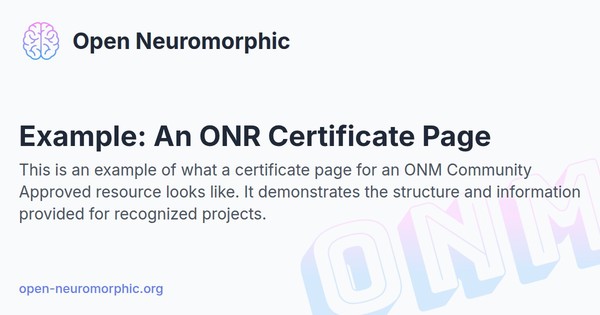Resource Details
- Link to Resource
- https://arxiv.org/abs/2109.12894
- Publication
- Example Publication Venue, 2025
- Community Approved On
- August 20, 2025
This is an Example Certificate Page
This page demonstrates what a certificate for a project approved by the Open Neuromorphic Research (ONR) program looks like. It serves as a template for prospective submitters to see how their work will be showcased after a successful community peer review.
A real certificate page would feature the actual abstract and a detailed overview of the approved resource. Below is an explanation of the sections you can expect to see.
Anatomy of a Certificate Page
Resource Details
The sidebar on this page contains key metadata and links related to the project:
- Link to Resource: A direct link to the primary resource (e.g., a GitHub repository, an arXiv pre-print, or a project website).
- Publication Venue & DOI: If applicable, details about formal publication.
- Authors: The names of the contributors, linking to their profiles on the ONM website.
- ONR Badge & Embed Code: A markdown snippet for the author to display the “ONM Community Approved” badge in their own project.
Abstract & Resource Overview
The main content area on a real certificate page is dedicated to showcasing the work itself. Instead of the example text below, this section would contain the actual abstract from the paper and a detailed overview of the resource, explaining its significance and how the community can use it.
Example Abstract
The backpropagation of error algorithm is arguably the most important algorithm in artificial intelligence, but has been deemed biologically implausible. In this placeholder study, we introduce a novel, biologically plausible learning rule inspired by the dynamics of astrocytic networks. Our model, termed Astro-Modulated Hebbian Learning (AMHL), demonstrates competitive performance with backpropagation on standard image classification benchmarks while requiring only local information for weight updates. We validate our findings through simulations on synthetic and real-world datasets, suggesting a viable path toward more brain-like on-chip learning.
Example Resource Overview
This resource consists of a pre-print manuscript and an accompanying open-source Python codebase. The codebase, implemented in PyTorch and
snnTorch, allows researchers to replicate all experiments presented in the paper. It includes scripts for data preprocessing, model training, and result visualization. We hope this work serves as a foundation for further exploration into glial-neural interactions in computational models.
This structure ensures that every approved project is presented clearly and professionally, providing a lasting testament to its quality and contribution to the open neuromorphic community.

